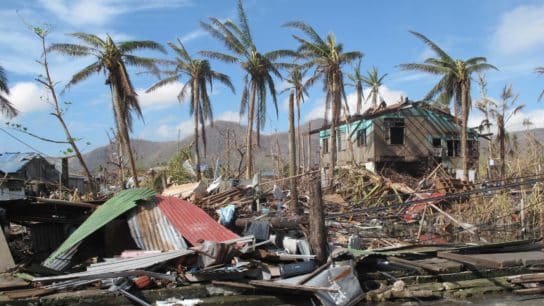While Australia releases about only 1% of global emissions at home, it was linked to about 4.5% once its fossil fuel exports were counted.
—
Australia’s fossil fuel exports contribute to global emissions more than any other country aside from Russia, owing particularly to the footprint of coal exports, according to a new report that suggests emissions will rise by 50% over the next decade.
The country’s climate footprint – roughly 4.5% of global fossil carbon dioxide (CO2) emissions, with 80% coming from coal and gas exports – “far exceeds” its economic size and population, the report says. Without fossil fuel exports, the country’s contribution to global emissions would be around 1%. Australia also remains the country with one of the highest per-capita emissions for all greenhouse gases, double that of China and nine times larger than India, the world’s first and third largest emitters, respectively.
The country ranked third in the world for fossil exports in 2021, behind only Russia and the US. In 2022, it accounted for 52% of global metallurgical coal exports and 17% of global thermal coal exports.
Coal, the cheapest and dirtiest fossil fuel, is the single-largest source of carbon emissions, responsible for over 0.3C of the 1.2C increase in global average temperatures since the Industrial Revolution. It is also a major contributor to air pollution.
Every year between 2015 and 2020, it also added 62 million tonnes of liquefied natural gas (LNG) capacity and has continued to sanction new large-scale projects in 2021 and 2022, according to the report. By 2035, Australia’s exports are projected to add 15 billion tonnes to the cumulative CO2 emissions its export sector generated since 1961, bringing the total to 45 billion tonnes.
‘Off Track’
Countries at last year’s COP28 summit pledged to “transition away” from planet-warming fossil fuels, the single-largest source of global greenhouse gas emissions. These emissions are the primary drivers of global warming as they trap heat in the atmosphere, raising Earth’s surface temperature.
Global fossil fuel consumption has more than doubled in the last 50 years, as countries around the world aim to improve their standards of living and economic output. In 2023, all three of the most potent GHGs – carbon dioxide (CO2), methane, and nitrous oxide – reached record highs.
The International Energy Agency (IEA) has urged countries to halt new gas and oil field projects, arguing that this is the only way to keep the 1.5C-compatible net-zero emissions scenario alive. However, Australia seems to go in the opposite direction.
“Australia has a responsibility not just to its own consumers of energy, but to the world,” the report read.
In April, Climatologist Zeke Hausfather said in a post on X (formerly Twitter) that “the ship has largely sailed on limiting warming to 1.5C at this point.” The comment refers to the most recent data on the planet’s remaining carbon budget, which suggested we had only 210 GtCO2 remaining at the start of 2024. Carbon budget refers the net amount of CO2 we have left to emit before we exceed our desired global temperature increases.
According to the report, Australia’s projected fossil fuel exports between now and 2035 would consume around 7.5% of the remaining carbon budget and around 9.1% considering Australia’s total
carbon footprint.
In 2015, 195 governments signed the Paris Agreement, setting the threshold for global average temperature rise to 1.5C above pre-industrial levels. But recent developments indicate that, for a 66% chance of meeting the Paris target, we would need to slash emissions from current levels to zero by 2030 or by 2035 for a 50% chance.
“It’s possible to expand the remaining carbon budget by removing more CO2 from the atmosphere than we emit, but even then it’s hard to come up with a plausible 1.5C scenario without overshoot and decline,” Hausfather said.
A recent exclusive survey conducted by the Guardian revealed that the 1.5C goal is increasingly out of reach, with nearly half of all lead authors and review editors of the Intergovernmental Panel on Climate Change (IPCC) reports since 2018 saying they believe humanity will breach the threshold. Of the 380 authors and editors interviewed by the Guardian, 132 (34.7%) expect global temperatures to rise by 2.5C this century, while 100 (26.3%) predict at least 3C of warming.
Among the scientists participating in the survey was Ruth Cerezo-Mota, an expert in climate modelling at the National Autonomous University of Mexico who said a 3C scenario is a “hopeful and conservative” estimate.
“There is not any clear sign from any government that we are actually going to stay under 1.5C,” she told the Guardian.
How can I contribute to a more sustainable planet?
- 🗳️ Vote for Climate Action: Exercise your democratic rights by supporting candidates and policies that prioritize climate change mitigation and environmental protection. Stay informed with Earth.Org’s election coverage.
- 👣 Reduce Your Carbon Footprint: Make conscious choices to reduce your carbon footprint. Opt for renewable energy sources, conserve energy at home, use public transportation or carpool, and embrace sustainable practices like recycling and composting.
- 💰 Support Environmental Organizations: Join forces with organizations like Earth.Org and its NGO partners, dedicated to educating the public on environmental issues and solutions, supporting conservation efforts, holding those responsible accountable, and advocating for effective environmental solutions. Your support can amplify their efforts and drive positive change.
- 🌱 Embrace Sustainable Habits: Make sustainable choices in your everyday life. Reduce single-use plastics, choose eco-friendly products, prioritize a plant-based diet and reduce meat consumption, and opt for sustainable fashion and transportation. Small changes can have a big impact.
- 💬 Be Vocal, Engage and Educate Others: Spread awareness about the climate crisis and the importance of environmental stewardship. Engage in conversations, share information, and inspire others to take action. Together, we can create a global movement for a sustainable future.
- 🪧 Stand with Climate Activists: Show your support for activists on the frontlines of climate action. Attend peaceful protests, rallies, and marches, or join online campaigns to raise awareness and demand policy changes. By amplifying their voices, you contribute to building a stronger movement for climate justice and a sustainable future.
For more actionable steps, visit our ‘What Can I do?‘ page.
This story is funded by readers like you
Our non-profit newsroom provides climate coverage free of charge and advertising. Your one-off or monthly donations play a crucial role in supporting our operations, expanding our reach, and maintaining our editorial independence.
About EO | Mission Statement | Impact & Reach | Write for us














